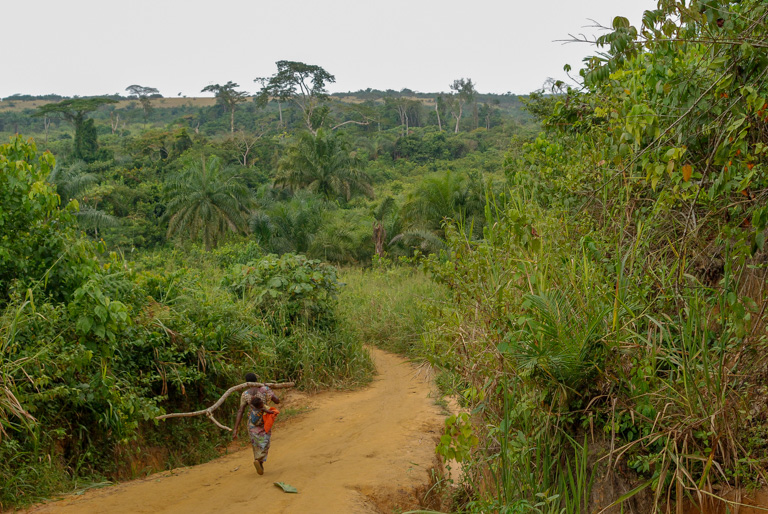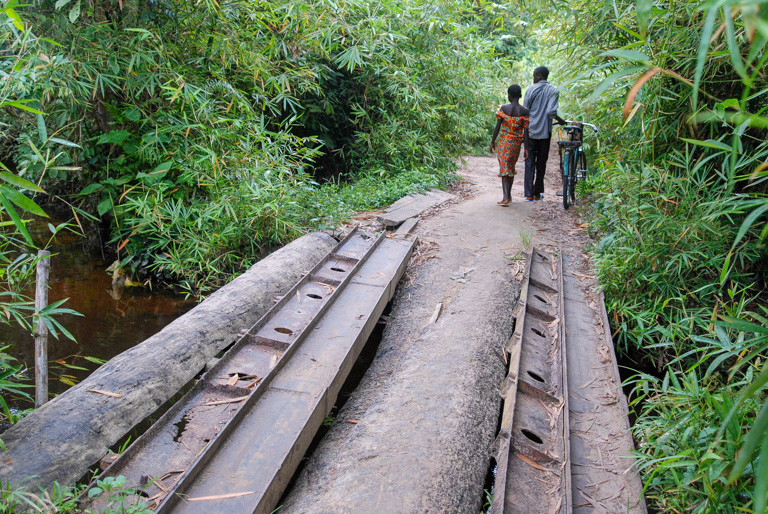- Logging roads in Central Africa cause greater loss of intact forest landscapes, or IFLs, on certified timber concessions compared to non-certified concessions, an analysis shows.
- Certified timber companies typically build more robust road networks that are more apt to show up on satellite imagery than non-certified companies.
- The findings highlight an apparent contradiction between certification for logging and the protection of IFLs, leading some critics to argue that IFL protection should not be part of the Forest Stewardship Council’s standards.
A recent analysis of logging roads in Africa’s Congo Basin has revealed that timber concessions certified by the Forest Stewardship Council (FSC) lost more blocks of untouched forests than non-certified concessions.
Those patches of forest, known as intact forest landscapes, or IFLs, became part of the sustainability certification organization’s policy in 2014. At that time, FSC’s membership, which includes timber companies as well as conservation NGOs, indigenous groups, and universities, passed a measure requiring the protection of 80 percent of the parts of certified concessions that are IFLs.
But when a timber company builds a road through untouched forest, it no longer qualifies as an IFL. By definition, an IFL is an area of forest at least 500 square kilometers (193 square miles) in area that bears no signs of human use. In the analysis, tropical ecologist Fritz Kleinschroth and his colleagues found that the logging roads on FSC-certified concessions showed up more prominently on satellite imagery than those built on non-certified concessions. That presents a contradiction in which concession holders who seek certification might be at a disadvantage.

“If we use this definition of IFL, which is based on the absence of any road, then it is not compatible with anything FSC actually certifies,” said Kleinschroth, a postdoctoral researcher at ETH Zurich in Switzerland.
He and his colleagues published their results in the journal Ambio on May 29.
Part of the issue is the way that scientists detect the presence of logging roads. The road networks installed by noncertified logging operations typically don’t show up as readily on the photographs snapped by satellite-mounted cameras. Kleinschroth explained that the canopy might hide them, but even less established roads can level hazards at the forest. These roads could provide a route for people to move into an area, where they might begin cutting down more trees for firewood and to make way for farms and hunting local wildlife to supplement their diets.
Certified concessions typically have more resources to develop more formal road networks. But to maintain compliance with FSC policies, they must also manage those roads to minimize the disturbances roads might cause, Kleinschroth said.
“FSC-certified companies make much more effort, for example, in providing alternative protein sources” to discourage hunting, he said. “They actually bring in meat from elsewhere and sell it for low prices to their employees, and that is not happening in other concessions.”
Kim Carstensen, FSC’s director general, said certified operations are also required to decommission roads after the company is done with them so that people can’t use them to access the forest and the area is allowed to bounce back after several years of harvests.
Such practices could benefit the forest over the long term, Carstensen said: “FSC-certified companies are much better placed to allow for regeneration and help in recovering the intactness of IFL forest areas because FSC certified forest concessions implement more efficient forest management practices that ultimately result in greater protection.”
He added, “What is important to consider here is that FSC certification requires forest companies that are certified with FSC to put in place safeguards that first, minimize impact … and secondly, that contribute to the regeneration of the area once harvest[ing] is completed.”

If certification is to become a tool to protect IFLs — alongside cordoned-off parks and preserves that don’t allow any human activity — Kleinschroth’s team suggests that the definition of IFLs “take into account more realistic and dynamic models of forest change,” they write. Under such a change, an area might regain its IFL status once it’s had a chance to recuperate.
But remote-sensing scientist Peter Potapov of the University of Maryland said the full recovery of a forest could take a century, during which humans would have to leave the forest completely untouched.
In 2017, Potapov and an international team of scientists reported that logging and agricultural expansion, along with mining and fires, spurred the global loss of 7 percent of IFLs between 2000 and 2013. More recent analyses indicate that the pace of IFL loss continues to accelerate.
Potapov said that even selective logging, as FSC-certified companies typically practice in tropical forests, will impact the services that forests provide. In their 2017 paper, he and his colleagues noted the importance of IFLs as habitat for biodiversity and their role as storehouses of carbon.
“If you start using it and providing access to these areas, the benefit of this … protection [is] gone,” Potapov said. “It’s not IFL anymore.”
He also raised the concern that even FSC-certified operators won’t be able to keep people out of the forest once it’s been logged.
“As soon as you open and raise this industrial infrastructure, especially in Africa, we will see a cascade of degradation effects,” Potapov said. “Companies will not be able to stop it.”
He added that integrating IFL protection into FSC standards doesn’t make sense.
“FSC should never even attempt to do this,” Potapov said. “It’s absolutely obvious that FSC is not helping protection of IFLs.”

But Kleinschroth said it was worth trying to reconcile some of those contradictions.
“For me, FSC clearly is making a huge effort with this,” he said, “and it wouldn’t make sense to push it too hard until it all falls apart.”
Forcing too onerous and costly a standard on companies that might otherwise go for certification could result in the loss of FSC certification as “one of the few instruments” that consumer countries have to promote more sustainable forestry in places like Central Africa, Kleinschroth added.
“I fully agree that we need to make every effort to protect every single bit of forest there is left for biodiversity,” he said. “But if we have too narrow a view on what we want to achieve and too little on what is actually possible and the policy implications of it, then we risk [asking] too much from the wrong stakeholders.”
Banner image of a western lowland gorilla by John C. Cannon/Mongabay.
John Cannon is a Mongabay staff writer based in the Middle East. Find him on Twitter: @johnccannon
Citations
Kleinschroth, F., Garcia, C., & Ghazoul, J. (2018). Reconciling certification and intact forest landscape conservation. Ambio, 1-7.
Potapov, P., Hansen, M. C., Laestadius, L., Turubanova, S., Yaroshenko, A., Thies, C., … & Esipova, E. (2017). The last frontiers of wilderness: Tracking loss of intact forest landscapes from 2000 to 2013. Science Advances, 3(1), e1600821.
FEEDBACK: Use this form to send a message to the author of this post. If you want to post a public comment, you can do that at the bottom of the page.














